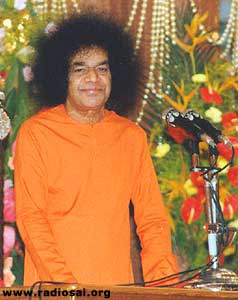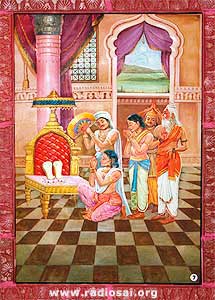 |
 |
 |
Volume
5 - Issue 03 MARCH 2007
|
SEEK ONENESS AND BLISS THROUGH RAMAYANA Ramayana is the Joint Epic of Rama and Sita
The term "Rama" means one who is pleasing and lovable. "Ayana" means movement or journey. "Ra" refers to Atma and "Ma" refers to Mind. The Rama Principle means merging the mind in the Atma. "Ramayana" means suffusing the world with the bliss of the Rama Principle. But it is not Sri Rama alone that is involved in this process, Sita is also an epic personality. "Rama" is another name for Sita. The Ramayana is thus a joint epic of Rama and Sita or Sita-Rama Ramayanam. Rarely in the world do we see married couples who are identical - man and wife - in their physical features, their qualities, behaviour, thoughts and capacities. But in the case of Rama and Sita the similarity was complete in every respect. There were no differences in features, qualities or other aspects. The truth of this is evident from what Hanuman experienced. Once Hanuman happened to look at Sita when she was alone. He got a doubt whether Rama Himself had assumed a feminine form. Looking at Sita, he thought it was Rama himself. Hence Rama and Sita should be regarded as one identical entity and not as separate beings. Role of Three Cities in Ramayana The inner significance of the Sita-Rama story will be clear when we consider the role of the three cities in the Ramayana. First comes Mithila. Emperor Janaka was its ruler. He was a Brahmajnaani (one who possesses knowledge of identity of individual self with the cosmic being) who had renounced everything. Like water on a lotus leaf, he was completely detached, with no concern for worldly things. Having no children of his own, he brought up with great love a foundling (Sita). There were two powerful entities in his kingdom - Siva's bow and Sita. Once, while engaging in play, Sita lifted the giant bow of Siva with astonishing ease. Struck by this feat, Janaka decided that Sita should be given in marriage only to one who could handle Siva's bow and be worthy of Sita's hand. With this resolve, he invited princes for Sita's svayamvara (self-selection of a husband by the bride herself). Rama arrived and lifted Siva's bow as lightly as Sita had done. Janaka realised that Rama and Sita were well matched in every respects - beauty, character and strength. Sita was no ordinary woman. She was the embodiment of Maha Maya (supreme divine illusion). Rama acquired Maha Maya as his consort. Sita, for her part, sought oneness with the Atma principle represented by Rama. The marriage of Rama and Sita represents the association of the Atma and the Maya. It is in this combined form of Atma and Maya that Rama entered Ayodhya. "Ayodhya" means "invincible". Its ruler was Dasaratha. Dasaratha means one who has made his ten indriyas (sense organs) the five organs of action and the five organs of perception—his chariot. Allegorically, this means that Dasaratha represents the body, with its ten organs. These sense organs are related to the three gunas (qualities) Satwa, Rajas, Tamas (goodness, passion, ignorance). Dasaratha's three wives - Kausalya, Sumitra and Kaikeyi - symbolise these three attributes. Dasarata's Four Sons Represent Four Vedas When one is influenced by gunas, he develops desires. The four sons of Dasaratha were the embodiments of his desires. Rama, Lakshmana, Bharatha and Satrughna symbolise the four Vedas Rig, Yajur, Sama and Atharvana. The Rig Veda figures in the Yajur and Sama Vedas to varying extent. It is the embodiment of Dharma. Yajur-Veda embodies mantras (sacred formulae). Lakshmana was continually engaged in contemplating about Rama and immersing himself in the Rama mantra. Bharata was one who could not bear separation from Rama and who was ever dwelling on Rama's name and form. He was the embodiment of Sama Veda. Shatrughna was one who had mastered all the sciences and used his powers for protecting his brothers. He was skilled in the use of all kinds of weapons. Thus the four Vedas, taking the form of the four brothers, were sporting in Dasaratha's palace… Ramayana is a Guide on Human Relationships
Among the four brothers there was boundless love and regard for each other. When Rama went to the forest and was in Chitrakuta, Bharatha came there to entreat him to return to Ayodhya and reign as the legitimate heir to the throne. Rama refused to return, saying that Bharatha should rule over Ayodhya in accordance with the promise given by Dasaratha. The argument between the two was ultimately resolved by Sage Vasishta who told Bharatha: “Do not cause any pain to Rama, who is Divinity itself and who has come down to protect the good and uphold Dharma." Bharatha pleaded for taking Rama's sandals and administering the kingdom in Rama's name till he returned to Ayodhya. There are a series of episodes in the Ramayana to show how deep was the love between the four brothers and how devoted were the younger brothers to Rama. Such fraternal love is an example to the world for all time. The Ramayana is a guidebook on the ideal relations between mothers and children, between husband and wife, between brothers, between the ruler and the people, between the master and the servants and many other human relationships. Rama showed compassion to the dying eagle Jatayu, which had fought with Ravana when he was carrying Sita away to Lanka and Rama gave refuge to Vibhishana, even against the fears expressed by Lakshmana. These are examples of Rama's supreme benevolence and magnanimity towards anyone who revered him or sought his protection. Rama declared to Lakshmana: "Anyone who comes to me in a spirit of surrender, whoever he might be, is mine and I am his. I shall give him asylum. This is my vow." Rama was a man pledged to one word, to one wife and to a single arrow. Devotees should install Rama in their hearts and celebrate Rama Navami for achieving Atmic bliss. Going through the Ramayana epic they should reach the state of "Atma-Rama" (oneness with the Universal Spirit). In such a state there is no Ahamkara (ego-sense). - Divine Discourse on Rama Navami, April 7, 1987. To read the complete text of this discourse, please click here. To read the first part of the Rama Story written by Swami Himself entitled “Rama Katha Rasavahini - I”, please click here. For the second part, click here. – Heart2Heart Team |
| You can write to us at : h2h@radiosai.org |
Vol 5 Issue 03 - MARCH 2007
|
Best viewed in Internet Explorer - 1024 x 768 resolution. |


